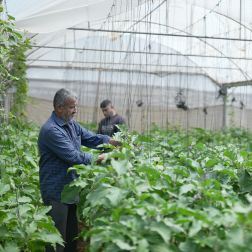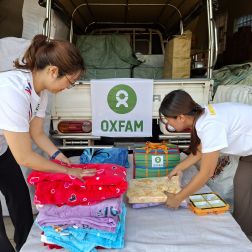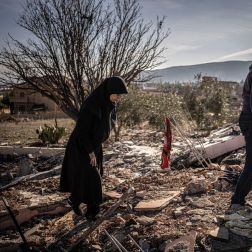- 5 mins read time
- Published: 4th April 2022
East Africa hunger crisis affecting 28 million

Climate-induced drought, conflict, and global food prices are all creating a humanitarian emergency.
In previous years in Wajir county, in northeast Kenya, Ahmed Mohamud Omar says the land was green, they could water their animals at nearby wells, and “our life was prosperous, we had milk and meat.”
“Now that the drought has hit, the animals have died,” he says. The 70 year old says he fears for the children of his community, and these days thinks mostly about what to eat, and where to get water.
“There is no happiness now,” he says.
People in the arid lands of northern Kenya, along with neighbouring Somalia and southern parts of Ethiopia, are now enduring an extensive drought due to the effects of climate change. Conflict in northern Ethiopia as well as unpredictable rains and flooding in South Sudan are disrupting agriculture and spreading hunger and suffering.
Oxfam estimates that 13 million people across Ethiopia, Kenya, and Somalia have been displaced in search of water and pasture, just in the first quarter of 2022. Millions of others had to flee their farmlands and homes due to conflicts, especially in northern Ethiopia – where 9.4 million people now need urgent humanitarian aid. East Africa has also suffered from the worst plague of locusts in 70 years. Kenya has suffered a 70 percent drop in crop production and has declared a national disaster with 3.1 million people facing acute hunger. As many as 28 million across the region could face severe hunger if rains do not fall.

Global crisis affecting East Africa
“East Africa faces a profoundly alarming hunger crisis,” says Gabriela Bucher, the executive director of Oxfam International who has just concluded a visit to affected areas of Kenya where expected March rains have so far not materialized. She says people in East Africa “are experiencing an unfolding full-scale catastrophe. Even if the rains do arrive this month, full recovery will be near impossible unless urgent action is taken today.”
Bucher says the humanitarian crisis is further complicated by recent hikes in food prices due to the pandemic, but also that there are “repercussions of the Ukrainian conflict on the global food system” affecting millions of people in East Africa (which imports 90 percent of its wheat from Russia and Ukraine), Yemen, and Syria, all coping with massively underfunded humanitarian emergencies. “Rising food prices will make the huge shortfall in aid potentially lethal,” Bucher says.
Severe situation in Kenya and East Africa
The climate crisis is having a dramatic impact on vulnerable communities. Droughts, floods, and disease outbreaks are more frequent and intense, leaving little opportunity for affected communities to recover from these successive shocks. Competition over resources also increases the risk of conflict. The UN is calling this “one of the worst climate-induced emergencies seen in recent history in the Horn of Africa.”
Idris Akhdar works for WASDA, an organisation that has partnered with Oxfam in Kenya for 21 years. He says that in recent visits to Wajir county, “Our team have met desperate people. People who are hungry, who are thirsty, and who are about to lose hope. In the last few days, I have seen across the region -- in the Somali region in Ethiopia, Somalia, and Kenya -- the same hunger and destitution all over.”
What Oxfam is doing to help people in East Africa
Oxfam is working with WASDA and others in Kenya to support 40,000 people, and planning to expand the support to approximately 240,000 people with cash for food and other essential items. Other work includes water, sanitation, and hygiene activities such as repairing water points and wells to provide access to safe drinking water, and hygiene promotion campaigns designed to reduce vulnerability to infectious diseases like cholera and COVID-19.
In Somalia, Oxfam is working with organizations including KAALO Aid and Development to reach 420,000 people this year with lifesaving water, sanitation and health support, including drilling wells, distributing hygiene kits, providing materials to help protect communities from water borne diseases, and distributing cash, seeds, tools, and training farmers in small-scale greenhouse farming. Oxfam will also support livestock treatment and vaccination campaigns together with the Ministry of Livestock, train community protection volunteers on gender-based violence issues, and distribute solar lamps to protect women and girls at night. To date we have reached more than 260,000 people.
In Ethiopia, Oxfam has supported 170,000 people in northern Ethiopia with lifesaving clean water, food, and cash assistance in areas affected by conflict. Oxfam aims to reach an additional 750,000 people in the next year in northern Ethiopia with emergency food packages, livelihoods assistance, clean water, sanitation, and hygiene kits. Together with our partners, we are also scaling up our work in the southern Somali region to respond to the effects of the drought.
In South Sudan, Oxfam has provided support to 400,000 people and aims to reach an additional 240,000 people with safe water, sanitation and hygiene services and promotion, cash grants for families to buy food and other essentials, and livelihood support like seeds, tools, and fishing kits.




